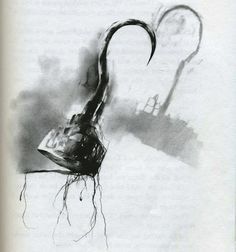Leave the Hookhand Murderer Alone

Scary stories are the best and I like them.
Don't worry: this is not a newsletter about how scary stories are bad.
Some scary stories, though, are best if you don't think about them at all, not even for an instant. For instance, the story about a family who brings home a dog from their vacation to Mexico, and then the dog turns out to be a rat that has some kind of fancy disease. When I read that story as a kid, I remember thinking, "Oh no, how scary! That dog was not a dog at all!" and then my brain immediately turned to other matters, such as how to catch the turtle that lived intermittently behind my Dad's lawnmower.
As an adult, upon extremely minimal reflection, I can see the roots of that story for what they are: white American xenophobia expressed as a fear of Mexican migrant workers coming into the United States. That story, which gets passed around as an urban legend, has troubling roots that are obvious the moment one even thinks to look for them.
This doesn't have to completely ruin the scare, of course — like any good urban legend, this story is malleable. Telling it around a campfire, one can easily change the context of the story to isolate the scary part — the dog that is not a dog. Racism, like any form of bigotry, isn't a necessary part of storytelling; and racism, like every form of bigotry, is baked into the way we talk about scary stories. This is because horror often reflects the fears of those who control the social narrative — white fear of people of color, heterosexual fear of the Queer Menace, able-bodied peoples' fear of disability and disabled people. Examining horror and classic scary stories to see what fears they really reflect is an incredibly useful way to examine the dominant cultural narrative, and whether or not we want to continue perpetuating the fears that those stories represent.
Which brings me to the most classic urban legend of all: The Hook Hand.

We all know this classic scary story: Two kids are out necking in a parked car, with the radio on, when a news alert interrupts the song they're listening to. A murderer is on the loose, escaped from either the local prison or the local mental institution, and he has a knife, and he has a hook for a hand, and he targets horny teens probably, watch out! Just then, there's a scratching noise on the outside of the car. The girl gets scared and tells the boy to take her home, and he does, and when he goes to open her car door for her, there's a dismembered bloody hook hanging off the handle of the passenger-side door.
CONGRATULATIONS, YOU HAVE BEEN SCARED
Okay, so, there are a lot of variations on this story. As above, the murderer can either be escaped from a prison or a mental institution. The teens in the car can either be making out, or having sex, or maybe the boy is pressuring the girl to have sex. Sometimes, the murderer has a knife; sometimes, he just has a hook. Usually, the boy drives the girl home and they find the hook later, but in versions that roam a bit, he goes out of the car to see what the noise is; the girl waits for a while, then hears a noise on top of the car, and when she gets out, the boy is murdered and hanging above the car.
There are a few obvious broad-cultural-fears involved here. Sexuality of any kind always adds an element of the visceral to horror, reminding the listener that they, too, live inside of a body that can suffer as the subjects of the story will. Teen sexuality in horror, as in the Hookhand Murderer Legend, serves several purposes. It reminds adults that teens live in bodies that can suffer; it reminds adults that teens can do things outside of the control and supervision of adults. It reminds teens that they live in bodies that can suffer, while also reminding them that they can go places and be independent. And, naturally, teen sexuality in horror marries all of those concepts together by reminding teens that if they go places to do things independent of adult supervision, there will be danger.
The next most-obvious fear in this story is the Escaped Murderer. A murderer by himself is scary enough — he is a person who has killed someone, someone who was once alive just the way you are now, and you don't know what might motivate him to kill you, too. But the Hookhand Murderer Legend is never just about a killer; it is invariably about an escaped killer. This facet of the story highlights a cultural fear of the failure of institutions that serve to imprison certain people. By making the idea of this man's escape frightening, this story reinforces the idea that prisons and prison-like mental institutions — places one would need to escape in order to be free — are good, and we should support them. After all, this story reminds the listener, you wouldn't want murderers on the loose, would you? Of course not! You want them in prison. Prison, the story says, is a good place for men like this one.
Next, we have the hook. I am disabled, but I do not use a prosthesis and am far from the best person to comment on disability representation in horror — notably, Elsa Sjunneson-Henry has much smarter things to say about this than I could ever hope to. That said, it doesn't take a close reading to note that the Hookhand Murderer in this story has a prosthesis. In popular imaginings of this man (as in the illustration above), the hook is like a meathook — it's sharp and it could easily rip a horny teenager to ribbons.
But that just doesn't make any fucking sense. If this murderer was in a prison or a mental institution, why would he be allowed to have a terrifying weapon as his prosthesis? It's far more likely that his hook is a functional one, designed to be useful for things other than murder. Having a functional hook as a prosthesis isn't scary, it's useful. But replacing the useful prosthesis with a frightening or grotesque one is a pretty direct way to reinforce a social fear of disability and people with disabilities — so in the story, that hook is better suited to gutting fish than functioning on a day-to-day basis.
This brings us to the end of the story: the hook hanging from the car door. This is scary because it's clear evidence that the murderer was trying to get into the car, presumably to engage in his favorite past-time of killing horny teens. But when one views this killer a little differently — as a man with a functional prosthesis, who was trapped in a prison system that is nightmarish and brutal and who has escaped — this ending reads a little differently. This story punishes the would-be-killer by taking away the device that functions as his prosthetic hand. This is a punishment that's repeated often in media across genres: a disabled villain is separated from his adaptive device, and the audience is asked to view it as justice.
Again, I'm not the person to go in-depth on disability representation in media. Lots of other people better-qualified than I have written and spoken about this, and you should give them your clicks. I do, however, feel very comfortable saying that disability and adaptive devices aren't scary, and using them to trigger fear in an audience plays on and reinforces the fears that surround ableism.
Besides which, it's just not a good ending to the story! The guy is still a murderer (and, remember, murderers are legitimately scary, because they might murder you)! And he still has one functional hand and also probably a knife! And he's going to want his hook back because those things are not cheap!
YOU ARE NOT SAFE, HORNY TEENS.
As with all urban legends, this one is malleable. That's what makes urban legends last: it's possible to shift them to fit a wide array of contexts, so they're easy to perpetuate. Here's a version of this story that I think does a decent job of engaging with legitimate fears, while abandoning the ones we don't need to perpetuate:
Okay, so, two horny teens are being horny at each other in a parked car, when they both hear that extremely loud Amber Alert noise on their phones. When they look at the message they've both received, it's not an Amber Alert — it's a push notification from the local police, who currently have the ability to send you texts that you can't ignore. The message says that a man is on a killing spree, and his murder weapon of choice is a meathook stolen from the local butcher shop, which is a very fancy butcher shop run by white people who charge $15 a pint for something they are calling 'bone broth,' which is indistinguishable from beef stock. (The butcher shop used to be a locally-owned grocery store, but I digress). The teens have been enjoying their Horny Teen Time in the car, but they decide to go home because they don't want to be out on the town with a murder-spree going on. As the Driving Teen goes to start the car, the Passenger Teen hears a noise outside — a noise like someone is trying to get one of the doors open. They drive away fast and scared. They almost don't make it home, because the gas tank is almost empty and gas costs like $8 a gallon, so it's not like they're going to stop and get a fill.
When they get home, the Driving Teen comes around to open the Passenger Teen's door — only to find a bloody meathook dangling from the handle.
CONGRATULATIONS, YOU HAVE BEEN SCARED







Member discussion